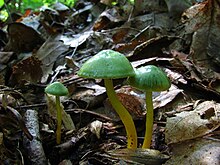Gliophorus psittacinus
| Gliophorus psittacinus | |
|---|---|

| |
| Scientific classification | |
| Domain: | Eukaryota |
| Kingdom: | Fungi |
| Division: | Basidiomycota |
| Class: | Agaricomycetes |
| Order: | Agaricales |
| Family: | Hygrophoraceae |
| Genus: | Gliophorus |
| Species: | G. psittacinus
|
| Binomial name | |
| Gliophorus psittacinus (Schaeff.) Herink (1958)
| |
| Synonyms[1] | |
| Gliophorus psittacinus | |
|---|---|
| Gills on hymenium | |
| Cap is convex | |
| Hymenium is adnate | |
| Stipe is bare | |
| Spore print is white | |
| Ecology is mycorrhizal | |
| Edibility is edible | |
Gliophorus psittacinus, commonly known as the parrot toadstool or parrot waxcap, is a colourful member of the genus Gliophorus, found across Northern Europe. It was formerly known as Hygrocybe psittacina, but a molecular phylogenetics study found it to belong in the genus Gliophorus. It had already been placed in Gliophorus, but it had been considered a synonym of Hygrocybe.[2]
Description[edit]

The parrot toadstool is a small mushroom, with a convex to umbonate cap up to 4 centimetres (1.6 in) in diameter, which is green when young and later yellowish or even pinkish tinged.[3] The stipe, measuring 2–8 cm (0.8–3.1 in) in length and 3–5 mm in width, is green to greenish yellow.[3] The broad adnate gills are greenish with yellow edges and spore print white. The green colouring persists at the stem apex even in old specimens. The spores are white, elliptical, smooth and inamyloid.[3]
Its odour and taste are mild.[3] There are no known chemical tests.
It fruits late summer to autumn (September to November).[4][5]
Distribution and habitat[edit]
Gliophorus psittacinus is widely distributed in grasslands in western Europe, United Kingdom, Iceland, Greenland, the Americas, South Africa, Japan, being found in late summer and autumn. In Europe it is apparently in decline due to the degradation of habitats. Early Australian records of this form have been found to be the similar green toadstools Gliophorus graminicolor or G. viridis on reexamination. Gliophorus psittacinus is known to occur at one site in the Lane Cove River valley near Sydney.[6]
Edibility[edit]
Gliophorus psittacinus is generally considered edible, but not worthwhile due to its small size and sliminess.[3][5]
References[edit]
- ^ "Gliophorus psittacinus (Schaeff.) Herink". MycoBank. International Mycological Association. Retrieved 2015-05-30.
- ^ Babos et al. 2011. Preliminary notes on dual relevance of ITS sequences and pigments in Hygrocybe taxonomy. Persoonia 26, 2011: 99–107
- ^ a b c d e Davis, R. Michael; Sommer, Robert; Menge, John A. (2012). Field Guide to Mushrooms of Western North America. Berkeley: University of California Press. pp. 123–124. ISBN 978-0-520-95360-4. OCLC 797915861.
- ^ Sterry, Paul (2007). A Photographic Guide to Mushrooms of Britain and Europe. Connaught. ISBN 978-1-84517-038-7.
- ^ a b "Parrot Waxcap". Wild Food UK. Retrieved 2020-09-06.
- ^ D.W. Noble, Fungi of the Sydney Region Facebook Group - July 2019
![]() Media related to Hygrocybe psittacina at Wikimedia Commons
Media related to Hygrocybe psittacina at Wikimedia Commons
